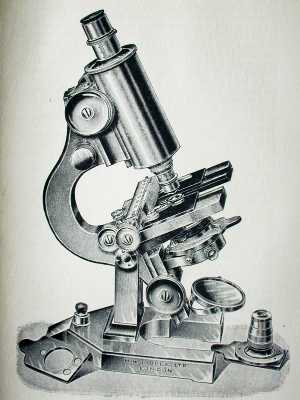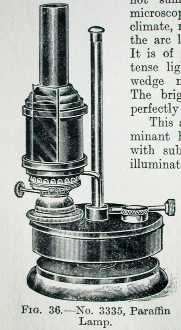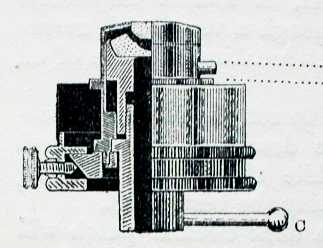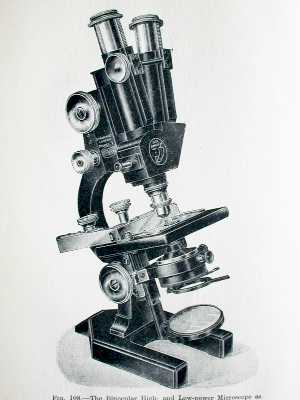 |
| What did it cost then? An insight into the value of microscopes of the 1920's period By Paul James (uk) |
Anyone who contemplates the 'value' of comparative prices of objects from two differing eras will soon run into difficulties arising from a multitude of problems. We all know about inflation, but there are other issues that can distort the calculations too. Mass production tends to reduce costs and prices, and social attitudes have change immensely over the last 100 years . The list of complications is endless, so whatever method we choose to make a comparison between two periods, the results must be taken loosely. Nevertheless it is interesting to make some efforts to see how 'expensive' new microscopes were in days gone by.
As an example I cite from the very pages of Conrad Beck's first edition of " The Microscope " printed in 1921. In keeping with many textbooks, and annual 'pocket' books of that era, adverts and prices were commonly quoted......perhaps an indication of more financially stable times? Though we can see the figures of cost, we cannot be absolutely certain about the 'value' of that amount in the lives of the people of the time. The figures quoted below are inevitably lower than that of today for a number of reasons, with inflation being perhaps the main culprit. But the calculation of relative values of the GBP pound between now and 1921 is very complex, and in the final analysis impossible to arrive at realistically. All figures cited are in decimalised form.
Between 1914 and 1921 there was a brief boom period, but whether this materially affected instrument prices is hard to determine. A Farm Labourer's average weekly wage was about £1.70 : A top class footballer £4.50! : Cottage prices rose to about £250 and houses up to about £500.
The Retail Price Index in the UK runs through from about 1915, and in 1921 the index figure was about 8.0 and today this exceeds about 175 or so. Thus the ratio between these two figures to date is about 22, which means that in theory the GBP's buying power has diminished by this factor. Housing price inflation has taken a different route it seems and adds to the interest and complexity. So with this loosely in mind the following instruments's prices take on a different perspective than would otherwise have been the case :-
 |
Examples
This is Beck's 'Massive' model above. It's an especially rigid version of a monocular stand having many features of use concerning high power observations. The fine focus is exceptionally delicate, and note the dovetail slide condenser unit which as the illustration shows sport's an objective : the ultimate condenser optic, that of illuminating like with like. A complete instrument with a full set of apochromats and binocular head which the maker's would recommend for this and achromatic aplanat substage optic was offered at :- £140 give or take a few pennies. This was very serious money even taking in to account the era of hand built instrumentation of the day. My loose reckoning makes this about £3300 in today's GBP money. But £140 was a very significant proportion of the cost of a house of the period, and might easily have been about a 1/3rd of a small cottage's value ?? Though this does not make sense to the younger generations, but it shows how the attitudes and priorities of society have changed dramatically since then, and how comparisons are only of academic interest.
 |
Here's a Beck portable stand intended for the pathologist on the move and was sold for £28 without optics. A set of achromats eyepieces and condenser would cost about £24, bringing this to about £52 total.
 |
This paraffin lamp could be bought for the seemingly modest sum of £2.75.
 |
Their high power immersion darkfield condenser, which is of the focussing type cost £6.12.
 |
This must have been a desirable instrument for an amateur of the period and would set him back about £38 without any optics. A modest three achromats at £10.00 and a triple objective changer comes at £1.20 and large abbe condenser with filter tray at £2.50 and two x10 Huygen eyepieces for £0.62! A total of £52.32p in contemporary money. That is equivalent to about 30 weeks wages for a farm labourer.
Final thoughts
Even taking on board the high complexity of rationalising prices between 1921 and today, and any errors extrapolated as a consequence, the simple fact is that the 'value' of microscopes has diminished significantly in today's world. A new quality instrument for the amateur today would cost about £1500 equivalent to that show above, yet the average house price where I live is in excess of £200,000. Thus the percentage comparison of these two items makes the microscope about 0.75 % of the value of a house, and nearer London more likely 0.4 %.
In 1921 that same comparison between the binocular microscope above and a house of the period would be bring about a figure of between 10-20%?!
To add sauce to this I only have to think of the prices of used 'scopes at Ebay.co.uk which would result in a comparitive figure of 0.1-0.2 %?
Had I lived in the early part of the 1900's I doubt very much whether I'd have had a peep through a microscope let alone own one. Today's commodity infested world has much wrong with it, but at least it gives the chance for more ordinary individuals like me to peep into a smaller one!
| All comments welcome by the author Paul James |
Microscopy
UK Front Page
Micscape
Magazine
Article
Library
Please report any Web problems or offer general comments to the Micscape Editor.
Micscape is the on-line monthly magazine of the Microscopy
UK web
site at Microscopy-UK